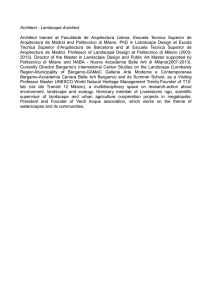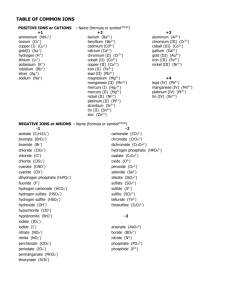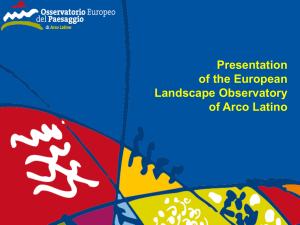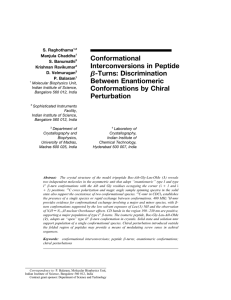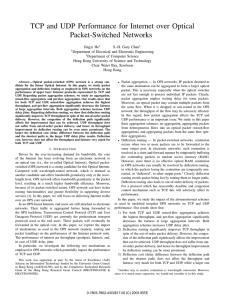What determines the native state folds of proteins
advertisement
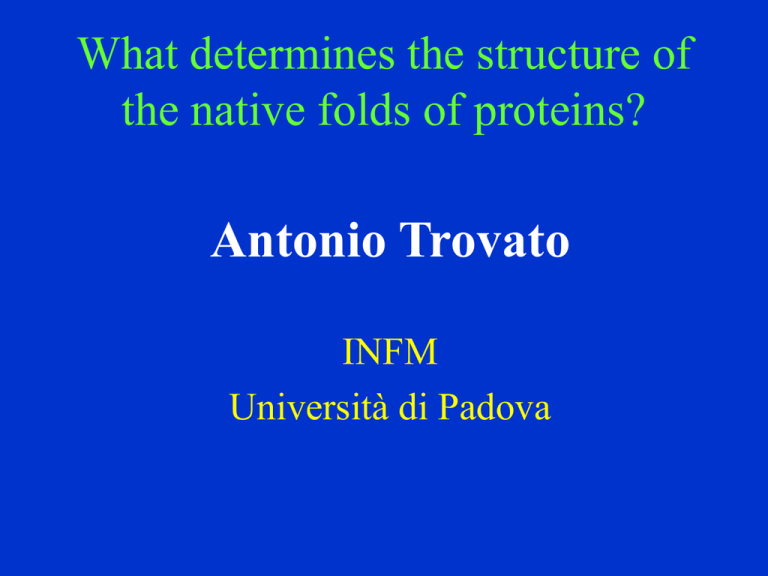
What determines the structure of the native folds of proteins? Antonio Trovato INFM Università di Padova Outline • Protein folding problem: native sequences vs. structures - sequences are many and selected by evolution - folds are few and conserved • Simple physical model capturing of main folding driving forces: hydrophobicity, sterics, hydrogen bonds • Protein energy landscape is presculpted by the general physical-chemical properties of the polypeptide backbone Protein Folding Problem • Central Dogma of Molecular Biology: DNA RNA Amino Acid Sequence (primary structure) Native conformation (tertiary structure) Biological Function • Anfinsen experiment: small globular proteins fold reversibly in vitro to a unique native state free energy minimum • Which Hamiltonian? • Which structure? • Levinthal paradox: how does a protein always find its native state in ms-s time? Energy landscape paradygm • Levinthal paradox: how to reconcile the uniqueness of the native state with its kinetic accessibility? Energy (from cubic lattice models) • Principle of minimal frustration Energy-entropy relationship is carving a funnel for designed sequences in the energy landscape Energy Conformations Conformations However Only a Limited Number of Fold Topology Exists Protein sequences have undergone evolution but folds have not…. they seem immutable - M. Denton &C. Marshall, Nature 410, 417 (2001). - C. Chotia & A.V. Finkelstein, Annu. Rev. Biochem. 59, 1007 (1990). - C. Chotia, Nature 357, 543 (1992). - C. P. Pointing & R.R. Russel, Annu. Rev. Biophys. Biomol. Struct. 31, 45 (2002). - A.V. Finkelstein, A.M. Gutun & A.Y. Badretdinov, FEBS Lett. 325, 23 (1993). Most common superfolds the same fold can house many different sequences and perform several biological functions can the emergence of a rich yet limited number of folds be explained by means of simple physical arguments? Compactness-Hydrophobicity H P Solvent Secondary structures Linus Pauling: Hydrogen bond is consistent with a and b motifs. L. Pauling & R.B. Corey, Conformations of polypeptides chains with favored orientations around single bonds: two new plated sheets, PNAS 37, 729-740 (1951); ibid with H.R. Branson 205-211. Steric constraints Ramachandran plot: Only certain regions in the phi-psi plane are allowed for most of the a.a.; constraints are specific G.N. Ramachandran & Sasisekharan, Conformations of polypeptides and proteins, Adv. Protein. Chem. 23, 283-438 (1968). Degrees of freedom b i i i i-th a All bond length and bond angles are kept fixed to180 5o slightly. except that NCaC’ bond angle is allowed pertubed Torsional angle about the peptide bond Strong Hint Both hydrogen bonding and steric interaction encourage secondary structure Thick Homopolymers Features & Motivations • Chain directionality breaks rotational symmetry of the tethered objects. • Need for a three body interaction. • Continuum limit without singular interaction potentials 2-body interaction must be discarded. • Nearby objects due to chain constraint do not necessarily interact. • Compact phase of relatively short thick polymers are different from the compact phase of the standard string and beads model. O. Gonzalez & J.H. Maddocks, PNAS 96, 4769 (1999). J.R. Banavar, O. Gonzalez, J.H. Maddocks & A. Maritan, J. Stat. Phys.110,35(2003). A. Maritan, C.Micheletti, A. Trovato & J.R. Banavar, Nature 406, 287 (2000) . J.R. Banavar, A. Maritan, C. Micheletti & A. Trovato, Proteins. 47, 315 (2002). J.R. Banavar, A. Flammini, D. Marenduzzo, A. Maritan & A. Trovato, ComPlexUs 1, 8 (2003). Optimal packing of short tubes leads to the emergence of secondary structures Optimal helix (pitch/radius=2.512..): generalization of Kepler problem for hard spheres Nearly parallel placement of different nearby portions of the tube Formulation of the Model Ca Representation • Tube Constraint (three-body constraint) • Hydrogen bonding geometric constraint • Hydrophobic interaction: e • Local bending penalty: e R W Formulation of the Model: Rules. H-Bond From 600 proteins in the PDB Ca Representa tion bi i rij j j+1 bj i+1 j-1 binormals at the j-th and i-th residues b i r ij b j bbj j 1 r ij How Many Parameters? Local i – i+3 eH = -1 Hydrogen bonding Non-Local i – i+5, i+6,… eH = -0.7 Remark: no H-bond between i – i+4 ! Cooperativity ecoop = -0.3 Ground State Phase Diagram eR = bending penalty ew = water mediated hydrophobic interaction No sequence specificity: HOMOPOLYMER 4 3 eR 2 Structureless 1 Swollen Compact ? 0 -5 -4 -3 -2 -1 0 eW +1 +2 +3 +4 bending energy Ground State Phase Diagram 4 3 eR 2 1 Structureless Compact Swollen 0 -5 -4 -3 -2 -1 0 eW +1 +2 +3 +4 attraction energy Ground State Phase Diagram All Minima In The Vicinity Of the Swollen Phase (Marginally Compact) Similar structures for longer chains (48 residues) Pre-sculpted energy landscape Sequence selection is easy! length = 24 Free Energy Landscape At Non Zero T Extended conformation is entropically favored: implication for aggregation in amyloid fibrils? Aggregation of short peptides Jimenez et al., EMBO J. 18, 815-821 (1999) Aggregation in amyloid fibrils is a universal feature of the polypeptide backbone chain Conclusions • Simple physical model capturing geometry and symmetry of main folding driving forces: hydrophobicity, sterics, hydrogen bonds • Proteinlike conformations emerge as coexisting energy minima for an isolated homopolymer in a marginally compact phase flexibility ; aggregation in amyloid fibrils is promoted increasing chain concentration • The energy landscape is presculpted by the physical-chemical properties of the polypeptide backbone; - design for folding is “easy”: neutral evolution - evolutionary pressure for optimizing protein-protein interaction (active sites, binding sites) and against aggregation Acknowledgments Jayanth R. Banavar Alessandro Flammini Trinh Xuan Hoang Davide Marenduzzo Amos Maritan Cristian Micheletti Flavio Seno (Penn State) (SISSA Trieste) (Hanoi) (Oxford) (INFM Padova) (SISSA Trieste) (INFM Padova)
